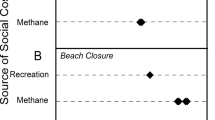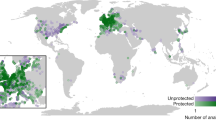Abstract
Governments worldwide do not adequately protect their limited freshwater systems and therefore place freshwater functions and attendant ecosystem services at risk. The best available scientific evidence compels enhanced protections for freshwater systems, especially for impermanent streams and wetlands outside of floodplains that are particularly vulnerable to alteration or destruction. New approaches to freshwater sustainability — implemented through scientifically informed adaptive management — are required to protect freshwater systems through periods of changing societal needs. One such approach introduced in the US in 2015 is the Clean Water Rule, which clarified the jurisdictional scope for federally protected waters. However, within hours of its implementation litigants convinced the US Court of Appeals for the Sixth Circuit to stay the rule, and the subsequently elected administration has now placed it under review for potential revision or rescission. Regardless of its outcome at the federal level, policy and management discussions initiated by the propagation of this rare rulemaking event have potential far-reaching implications at all levels of government across the US and worldwide. At this timely juncture, we provide a scientific rationale and three policy options for all levels of government to meaningfully enhance protection of these vulnerable waters. A fourth option, a 'do-nothing' approach, is wholly inconsistent with the well-established scientific evidence of the importance of these vulnerable waters.
This is a preview of subscription content, access via your institution
Access options
Access Nature and 54 other Nature Portfolio journals
Get Nature+, our best-value online-access subscription
$29.99 / 30 days
cancel any time
Subscribe to this journal
Receive 12 print issues and online access
$259.00 per year
only $21.58 per issue
Buy this article
- Purchase on Springer Link
- Instant access to full article PDF
Prices may be subject to local taxes which are calculated during checkout



Similar content being viewed by others
References
Freeman, M. C., Pringle, C. M. & Jackson, C. R. Hydrologic connectivity and the contribution of stream headwaters to ecological integrity at regional scales. J. Am. Wat. Resour. Assoc. 43, 5–14 (2007).
Leigh, C. et al. Ecological research and management of intermittent rivers: an historical review and future directions. Freshwater Biol. 61, 1181–1199 (2016).
Cohen, M. J. et al. Do geographically isolated wetlands influence landscape functions? Proc. Natl Acad. Sci. USA 113, 1978–1986 (2016).
Shook, K. R. & Pomeroy, J. W. Memory effects of depressional storage in Northern Prairie hydrology. Hydrol. Process. 25, 3890–3898 (2011).
Kelleher, C., Wagener, T. & McGlynn, B. Model-based analyses of the influence of catchment properties on hydrologic partitioning across five mountain headwater subcatchments. Wat. Resour. Res. 51, 4109–4136 (2015).
Tetzlaff, D. et al. A preliminary assessment of water partitioning and ecohydrological coupling in northern headwaters using stable isotopes and conceptual runoff models Hydrol. Process. 29, 5153–5173 (2015).
Alexander, R. B. et al. The role of headwater streams in downstream water quality. J. Am. Water Resour. Assoc. 43, 41–59 (2007).
Marton, J. M. et al. Geographically isolated wetlands are important biogeochemical reactors on the landscape. Bioscience 65, 408–418 (2015).
Rains, M. C. et al. Geographically isolated wetlands are part of the hydrological landscape. Hydrol. Process. 30, 153–160 (2016).
Kirkman, L. K, Drew, M. B., West, L. T. & Blood, E. R. Ecotone characterization between upland longleaf pine/wiregrass stands and seasonally-ponded isolated wetlands. Wetlands 18, 346–364 (1998).
Semlitsch, R. D. & Bodie, J. R. Are small, isolated wetlands expendable? Conserv. Biol. 12, 1129–1133 (1998).
Snodgrass, J. W., Komoroski, M. J., Bryan, A. L. & Burger, J. Relationships among isolated wetland size, hydroperiod, and amphibian species richness: implications for wetland regulations. Conserv. Biol. 14, 414–419 (2000).
Finn, D. S., Bonada, N., Múrria, C. & Hughes, J. M. Small but mighty: headwaters are vital to stream network biodiversity at two levels of organization. J. N. Am. Benthol. Soc. 30, 963–980 (2011).
Connectivity of Streams and Wetlands to Downstream Waters: A Review and Synthesis of the Scientific Evidence Technical Report, EPA/600/R-14/475F (US Environmental Protection Agency, 2015).
Olsen, A. R. & Peck, D. V. Survey design and extent estimates for the Wadeable Streams Assessment. J. North Am. Benthological Soc. 27, 822–836 (2008).
Lane, C. R. & D'Amico, E. Identification of putative geographically isolated wetlands of the conterminous United States. J. Am. Water Resour. Assoc. 52, 705–722 (2016).
Creed, I. F., Sanford, S. E., Beall, F. D., Molot, L. A. & Dillon, P. J. Cryptic wetlands: integrating hidden wetlands in regression models of the export of dissolved organic carbon from forested landscapes. Hydrol. Process. 17, 3629–3648 (2003).
Bishop, K. et al. Aqua Incognita: the unknown headwaters. Hydrol. Process. 22, 1239–1242 (2008).
Hill, B. H., Kolka, R. K., McCormick, F. H. & Starry, M. A. A synoptic survey of ecosystem services from headwater catchments in the United States. Ecosyst. Serv. 7, 106–115 (2014).
Nadeau, T. L. & Rains, M. C. Hydrological connectivity between headwater streams and downstream waters: how science can inform policy. J. Am. Water Resour. Assoc. 43, 118–133 (2007).
Adusumulli, N. Valuation of ecosystem services from wetlands mitigation in the US. Land 4, 182–196 (2015).
Ghermandi, A., Van Den Bergh, J. C., Brander, L. M, de Groot, H. L. & Nunes, P. A. Values of natural and human-made wetlands: a meta-analysis. Water Resour. Res. 46, W12516 (2010).
Beaulieu, J. J. et al. Urban stream burial increases watershed-scale nitrate export. PLoS One 10, e0132256 (2015).
Fritz, K. M. et al. Comparing the extent and permanence of headwater streams from two field surveys to values from hydrographic databases and maps. J. Am. Water Resour. Assoc. 49, 867–882 (2013).
Calhoun, A. J. K. et al. Temporary wetlands: challenges and solutions to conserving a 'disappearing' ecosystem. Biol. Conserv. 211, 3–11 (2017).
Millett, B., Johnson, W. C., Guntenspergen, G. Climate trends of the North American prairie pothole region 1906–2000. Clim. Change 93, 243–267 (2009).
Dixon, M. J. R. et al. Tracking global change in ecosystem area: the Wetland Extent Trends index. Biol. Conserv. 193, 27–35 (2016).
Acuña, V. et al. Why should we care about temporary waterways? Science 343, 1080–1081 (2014).
Datry, T., Larned, S. T. & Tockner, K. Intermittent rivers: a challenge for freshwater ecology. BioScience 64, 229–235 (2014).
Acuña, V., Hunter M. & Ruhl, A. Managing temporary streams and rivers as unique rather than second-class ecosystems. Biol. Conserv. 211, 12–19 (2017).
Bedford, B. L. Cumulative effects on wetland landscapes: links to wetland restoration in the United States and southern Canada. Wetlands 19, 775–788 (1999).
Carpenter, S. R. et al. Early warnings of regime shifts: a whole-ecosystem experiment. Science 332, 1079–1082 (2011).
Capon, S. J. et al. Regime shifts, thresholds and multiple stable states in freshwater ecosystems; a critical appraisal of the evidence. Sci. Total Environ. 534, 122–130 (2015).
Van Meter, K. J. & Basu, N. B. Signatures of human impact: size distributions and spatial organization of wetlands in the Prairie Pothole landscape. Ecol. Appl. 25, 451–465 (2015).
Golden, H. E. et al. Integrating geographically isolated wetlands into land management decisions. Front. Ecol. Environ. http://dx.doi.org/10.1002/fee.1504 (2017).
Uden, D. R., Hellman, M. L., Angeler, D. G. & Allen, C. R. The role of reserves and anthropogenic habitats for functional connectivity and resilience of ephemeral wetlands. Ecol. Appl. 24, 1569–1582 (2014).
Vanderhoof, M. K., Alexander, L. C., Todd, J. M. Temporal and spatial patterns of wetland extent influence variability of surface water connectivity in the Prairie Pothole Region, United States. Landscape Ecol. 31, 805–824 (2016).
Evenson, G. R., Golden, H. E., Lane, C. R. & D'Amico, E. An improved representation of geographically isolated wetlands in a watershed-scale hydrologic model. Hydrol. Process. 30, 4168–4184 (2016).
Ameli, A. A. & Creed, I. F. Quantifying hydrologic connectivity of wetlands to surface water systems. Hydrol. Earth Syst. Sci. 21, 1791–1808 (2017).
McDonnell, J. J. & Beven, K. Debates—the future of hydrological sciences: a (common) path forward? A call to action aimed at understanding velocities, celerities and residence time distributions of the headwater hydrograph. Wat. Resour. Res. 50, 5342–5350 (2014).
Smith, R. D., Ammann, A., Bartoldus, C. & Brinson, M. M. An Approach for Assessing Wetland Functions Using Hydrogeomorphic Classification, Reference Wetlands, and Functional Indices (US Army Corps of Engineers, 1995).
Alberta Wetland Policy (Edmonton, Alberta) (Government of Alberta, 2013).
Creed, I. F., Aldred, D. A., Serran, J. N. & Accatino, F. in Wetland and Stream Rapid Assessments: Development, Validation, and Application (eds Dorney, J., Savage, R., Tiner, R. & Adamus, P.) (Elsevier, in the press).
Moreno-Mateos, D., Power, M. E., Comín, F. A. & Yockteng, R. Structural and functional loss in restored wetland ecosystems. PLoS Biol. https://dx.doi.org/10.1371/journal.pbio.1001247 (2012).
Ehrenfeld, J. G. Defining the limits of restoration: the need for realistic goals. Restoration Ecol. 8, 2–9 (2000).
Groot, R. S. et al. Benefits of investing in ecosystem restoration. Conserv. Biol. 27, 1286–1293 (2013).
Wang, X. et al. Simulated wetland conservation-restoration effects on water quantity and quality at watershed scale. J. Environ. Manage. 91, 1511–1525 (2010).
Darwiche-Criado, N. et al. Effects of wetland restoration on nitrate removal in an irrigated agricultural area: the role of in-stream and off-stream wetlands. Ecol. Eng. 103, 426–435 (2017).
Junk, W. J. et al. Current state of knowledge regarding the world's wetlands and their future under global climate change: a synthesis. Aquat. Sci. 75, 151–167 (2013).
Davidson, N. C. How much wetland has the world lost? Long-term and recent trends in global wetland area. Mar. Freshwater Res. 65, 934–941 (2014).
Dahl, T. E. Wetland losses in the United States 1780s to 1980s (US Department of the Interior, Fish and Wildlife Service, 1990).
Environmental Dataset Gateway (US Environmental Protection Agency, accessed 28 June 2017); ftp://newftp.epa.gov/epadatacommons/ORD/EnviroAtlas/PRWAg.zip
Homer, C. et al. Completion of the 2011 national land cover database for the conterminous United States — representing a decade of land cover change information. Photogramm. Eng. Remote Sens. 81, 345–354 (2015).
Acknowledgements
This Perspective arose from a 'Geographically Isolated Wetlands Research Workshop' co-hosted by the US Environmental Protection Agency (US EPA) Office of Research and Development, and the Joseph W. Jones Ecological Research Center in Newton, Georgia, 18–21 November, 2013. This Perspective also benefited from discussions held at the 'Connectivity of Geographically Isolated Wetlands to Downstream Waters' Working Group supported by the John Wesley Powell Center for Analysis and Synthesis, funded by the US Geological Survey and the US EPA Office of Research and Development, National Exposure Research Laboratory. We acknowledge Rose Kwok of the US EPA Office of Water, for her contributions to the history of the US CWA (Supplementary Section 1) and Brian Hill of the US EPA Office of Research and Development, for his contributions to the data used in the calculation of ecosystem services (Supplementary Section 2). The findings, conclusions and views expressed in this article are those of the authors and do not necessarily reflect the views or policies of the US EPA or the US Fish and Wildlife Service.
Author information
Authors and Affiliations
Contributions
I.F.C. and C.R.L. co-led and co-wrote the Perspective with contributions from all co-authors. I.F.C., J.R.C., K.C.R. and J.N.S. contributed to the figures.
Publisher's note: Springer Nature remains neutral with regards to jurisdictional claims in published maps and institutional affiliations.
Corresponding author
Ethics declarations
Competing interests
The authors declare no competing financial interests.
Supplementary information
Supplementary Information
Supplementary Texts and Tables (PDF 571 kb)
Rights and permissions
About this article
Cite this article
Creed, I., Lane, C., Serran, J. et al. Enhancing protection for vulnerable waters. Nature Geosci 10, 809–815 (2017). https://doi.org/10.1038/ngeo3041
Received:
Accepted:
Published:
Issue Date:
DOI: https://doi.org/10.1038/ngeo3041
This article is cited by
-
Deep learning for water quality
Nature Water (2024)
-
Effects of generations in captivity and elevated rearing temperature on Ontario hatchery brook trout (Salvelinus fontinalis) fry quality and survival
Environmental Biology of Fishes (2024)
-
A Multicriteria Model for the Assessment of Source Water Contamination by Anthropogenic Activities to Support Land Use Management
Environmental Modeling & Assessment (2024)
-
National hydrologic connectivity classification links wetlands with stream water quality
Nature Water (2023)
-
Extensive global wetland loss over the past three centuries
Nature (2023)



